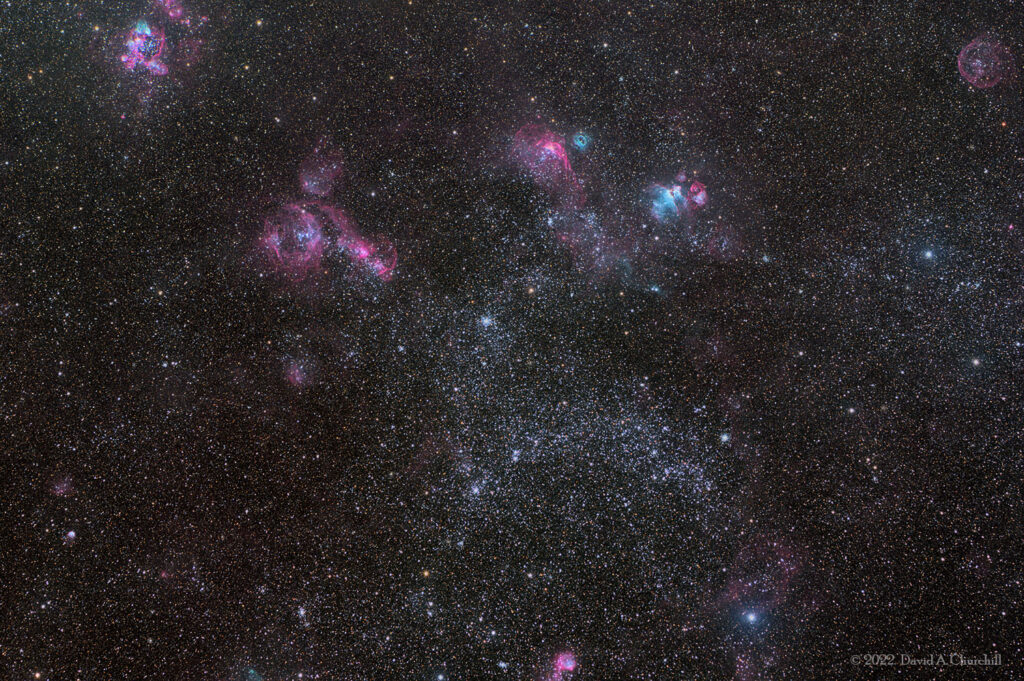Region within the LMC
Star Clusters & Nebulae within the Large Magellanic Cloud, Dorado
- Description
- Technical
- Links
The Large Magellanic Cloud (LMC), or Nubecula Major is a satellite galaxy of the Milky Way. This image shows an area just West of the Tarantula Nebula. The large Star Cluster NGC 2027 is at the center, with a Globular Cluster, NGC 2011 just above and left of center. Several Emission Nebulae – NGC 1968 & NGC 1955 are above left of this, with NGC 1934 & NGC 1935 in the top left corner. NGC 2014 is above right of center with NGC 2020 & NGC 2032 just to the right of this. LH120-No70 can also be seen in the top right corner. There are many other objects contained in this image.
At a distance of around 50 kiloparsecs (≈160,000 light-years), the LMC is the second- or third-closest galaxy to the Milky Way, after the Sagittarius Dwarf Spheroidal (~16 kpc) and the possible dwarf irregular galaxy known as the Canis Major Overdensity. Based on the D25 isophote at the B-band (445 nm wavelength of light), the Large Magellanic Cloud is approximately 9.86 kiloparsecs (32,200 light-years) across. It is roughly a hundredth as massive as the Milky Way and is the fourth-largest galaxy in the Local Group, after the Andromeda Galaxy (M31), the Milky Way and the Triangulum Galaxy (M33).
The LMC is classified as a Magellanic spiral. It contains a stellar bar that is geometrically off center, suggesting that it was a barred dwarf spiral galaxy before its spiral arms were disrupted, likely by tidal interactions from the Small Magellanic Cloud (SMC) and the Milky Way’s gravity.
With a declination of about −70°, the LMC is visible as a faint “cloud” from the southern hemisphere of the Earth and from as far north as 20° N. It straddles the constellations Dorado and Mensa and has an apparent length of about 10° to the naked eye, 20 times the Moon’s diameter, from dark sites away from light pollution. The Milky Way and the LMC are predicted to merge in approximately 2.4 billion years.
At a distance of around 50 kiloparsecs (≈160,000 light-years), the LMC is the second- or third-closest galaxy to the Milky Way, after the Sagittarius Dwarf Spheroidal (~16 kpc) and the possible dwarf irregular galaxy known as the Canis Major Overdensity. Based on the D25 isophote at the B-band (445 nm wavelength of light), the Large Magellanic Cloud is approximately 9.86 kiloparsecs (32,200 light-years) across. It is roughly a hundredth as massive as the Milky Way and is the fourth-largest galaxy in the Local Group, after the Andromeda Galaxy (M31), the Milky Way and the Triangulum Galaxy (M33).
The LMC is classified as a Magellanic spiral. It contains a stellar bar that is geometrically off center, suggesting that it was a barred dwarf spiral galaxy before its spiral arms were disrupted, likely by tidal interactions from the Small Magellanic Cloud (SMC) and the Milky Way’s gravity.
With a declination of about −70°, the LMC is visible as a faint “cloud” from the southern hemisphere of the Earth and from as far north as 20° N. It straddles the constellations Dorado and Mensa and has an apparent length of about 10° to the naked eye, 20 times the Moon’s diameter, from dark sites away from light pollution. The Milky Way and the LMC are predicted to merge in approximately 2.4 billion years.
Telescope: Astro Physics 155EDF (TCC) f5.4
Mount: Astro Physics 1600GTO
Camera: FLI PL29050 / CFW2-7
Guider: Agena Starguide II / ZWO ASI178MM
Filters: Astrodon II 50mm LRGB
L: 43×10 mins = 430 mins, R: 24×10 mins = 240 mins, G: 24×10 mins = 240 mins, B: 24×10 mins = 240 mins
Total Imaging Time: 19h 10m
Data Imaged remotely over 5 nights during September 2022.
Imaged from Observatorio El Sauce, Chile, in partnership with Fred Espenak.
Data acquisition & Processing by David Churchill.
None

